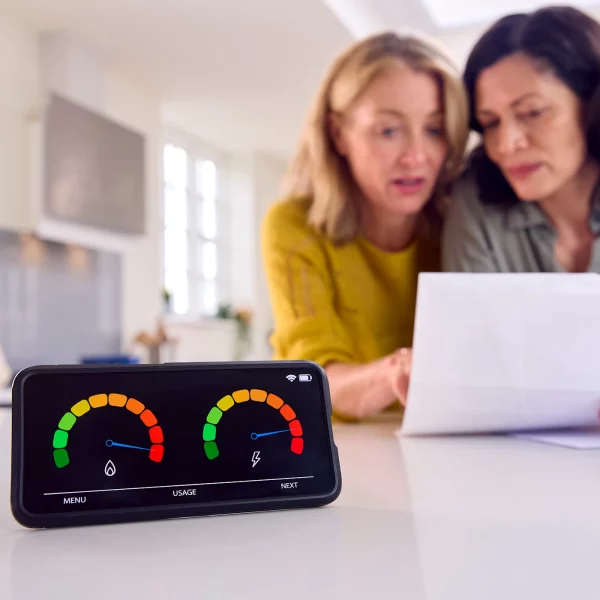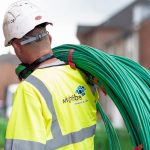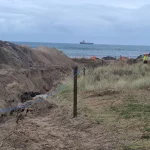Energy Smart Meters May Soon Link via UK Home Broadband Connectivity

A new Government consultation has revealed that the Data Communications Company (DCC), which is in the process of working to upgrade existing Smart Meters in UK homes with a new 4G Communication Hub (here and here), will in 2026 also launch a Virtual WAN service. This will mean that home broadband can be used to connect premises not covered by their normal wireless network.
Just to recap. The ongoing efforts to switch off older 2G and 3G based mobile networks across the UK will ultimately cause problems for the many Smart Meters installed across the rest of England and Wales, which utilise the same technology via O2 (Scotland and the North of England use a different LRR wireless system). Due to this, Vodafone has already been contracted to help upgrade millions of meters to a new 4G connection.
However, regardless of which wireless system DCC uses to automatically send its energy meter readings, one of the problems with Smart Meters is that the wireless signal strength and coverage isn’t always good enough to reach every single meter. The logical solution would thus to be to develop an alternative method that could connect such meters via your home broadband and WiFi connectivity, but it’s not quite that simple.
Advertisement
One of the issues with using home connectivity as a backup or the main data link for Smart Meters is that it risks exposing Critical National Infrastructure (CNI) to the public internet (e.g. imagine a hostile state hacking meters and disrupting the service etc.). Some halfway solutions, such as the Home Mini device from Octopus Energy, do exist, but they have limits and aren’t part of the main centralised DCC connectivity.
So what’s new?
Back in December 2023 the previous Government’s Department for Energy Security & Net Zero (DESNZ) started to change their tune by issuing a new consultation. This included proposals to create arrangements whereby communications with Smart Metering Systems installed in premises with no Wide Area Network (“No-WAN premises”) could be established via the DCC through use of the consumer’s own internet connection.
At the start of 2025 this was followed by the current Government proposing to implement such a programme (here), which included proposed architectural arrangements – factoring in the need for tight security – for a new Virtual WAN (VWAN) solution. Just to be clear, the current 2G/3G/4G and LRR wireless data solutions for connecting Smart Meters involves a Wide Area Network (WAN) to link the Communications Hub inside meters with the DCC.
The latest development in this process cropped up yesterday after the Government published another consultation on the need for new energy supplier obligations to drive non-domestic Smart Meter uptake post-2025 (here), which ISPreview noticed included this little piece of interesting and related information.
Advertisement
Extract from the Consultation
Virtual WAN: The DCC will in 2026 launch a Virtual WAN service, so that with consumer consent, broadband can be used to connect premises without WAN coverage, to the national communications network for smart metering. This means that all remaining consumers who do not have a WAN service, but have broadband, will be eligible for smart meters.
This is quite a significant development for home Smart Meters, although previous studies indicated that its target reach will initially be quite limited: “The intent of the [VWAN] arrangements is to support consumers in the 328,000 No-WAN premises across all areas of GB. Our assessment is that, taking into account the need for sufficient internet, up to 95% of these premises would benefit from the [VWAN] solution“.
However, it is also recognised that, over time, we might see this functionality become available as a general backup for the existing wireless communication methods (e.g. 4G) used inside Smart Meters. The government’s consultations appear to indicate that the functionality to establish these VWAN connections may be included in a number of different types of devices, such as In-Home Displays (IHD), Prepayment Meter Interface Devices (PPMID), a stand-alone device, or a Consumer Access Device (CAD). A specialised IHD would seem like a logical and easy solution to deploy it.
The exact details of how this will all be pieced together into a deployable solution – one that is safe and works well enough to be placed into homes – is of course up to the DCC to finalise. But that 2026 date seems – at least to us – to be quite an ambitions target for such a development. Either way, this is one to watch.
Mark is a professional technology writer, IT consultant and computer engineer from Dorset (England), he also founded ISPreview in 1999 and enjoys analysing the latest telecoms and broadband developments. Find me on X (Twitter), Mastodon, Facebook, BlueSky, Threads.net and Linkedin.
« Survey Claims Half of UK Broadband Users Leave Routers Open to Cyberattack
Advertisement
Leave a Reply Cancel reply
Privacy Notice: Please note that news comments are anonymous, which means that we do NOT require you to enter any real personal details to post a message and display names can be almost anything you like (provided they do not contain offensive language or impersonate a real person�s legal name). By clicking to submit a post you agree to storing your entries for comment content, display name, IP and email in our database, for as long as the post remains live.
Only the submitted name and comment will be displayed in public, while the rest will be kept private (we will never share this outside of ISPreview, regardless of whether the data is real or fake). This comment system uses submitted IP, email and website address data to spot abuse and spammers. All data is transferred via an encrypted (https secure) session.























































I wonder if this is linked to some of the work Octopus Energy have been doing with their Octopus Mini, which connects by ZigBee and WiFi. They have been rather vocal at wanting changes to allow billing via WiFi due to so many people having issues with connecting over mobile or radio depending on the region.
There are third party displays such as the one from Glowmarkt that can link to Wifi to pass real time data to a smart phone app. It’s ridiculous that it’s taken this long to make smart meters capable of being linked to Wifi. I know it’s a security issue but it must be possible to sandbox meters so that malicious code cannot enter via a Wifi connection. The trouble is by all accounts the energy companies are pretty crap at IT which partly explains why the smart meter rollout has been such as disaster.
I had one of those in 2017 – It was a trial Bright were doing – passed it all onto EDF and also paired to my phone. I agree – it’s been out for a long time now.
When my smart meter was installed, I was not given an IHD as it was supposed to be sent out later. My provider went bust so I never received one.
I bought my own from Glowmarkt that connects to my home wi-fi, and I can use the Bright App or the local MQTT feed into Home Assistant where I get my main usage/costs from.
DCC feed still works to my current provider after moving off Octopus and their Home Mini device.
@Big Dave:
6G is being architected for networks dedicated to servicing IoT assets.
@Big Dave
I would say that not all energy companies are crap at IT.
The big 6 absolutely were.
Octopus bucked the trend with their tech first approach and built from the ground up Kraken system. It’s primarily why they are now the largest energy supplier.
EON, EDF and maybe others have migrated to Kraken and pay Octopus to use it as they couldn’t come close to it themselves.
However it you check Octopus’s blogs, there’s one that goes into detail about how the smart meter provisioning works. It is absolutely insane and hideously complex for what it is.
There are so many minor steps in the process, over a dozen actions that need to go through for it to work. If one fails then they may have to start from scratch.
Honestly it is insane and makes absolutely no sense, so I would place most of the blame on the government’s incompetence on designing (whichever department was responsible for the rollout)
…and those of us that run a fully wired network that doesn’t use wireless can…?
Plus the fact, if any clown that thinks they’re connecting a “smart” meter to my network they can think again.
As I understand it, they may be able to facilitate a wired connection too, it’s somewhat immaterial whether it’s WiFi or LAN/Wired. But as above, they would need your consent so you can say no.
I hope it does have an RJ45 – I am one of many people who don’t use WIFI at all. I am all hard wired.
If you have a service provider-supplied broadband hub, the provider can configure dedicated VLANs on it that you would not know about.
@Mark Jackson and no, I would say. Not that I have smart meters and have no interest in having any, takes me a couple of minutes to read my meters.
If they want me to use my router for their services, then they can reduce the price of my energy, simple as that.
RJ45?, on the meter which may be on the external side of the property?
I think not, corrosion etc unless it is in a humidity proof enclosure.
On BT Group-supplied Hubs, there is a public WiFi service that is configured by default. This does not use the customer’s network and does not count towards bandwidth usage. The customer used to be able to turn this off, but I’m not sure that option exists anymore.
The same approach can be used for IoT devices in the home – i..e the provider could configure a dedicated virtual connection for devices around the premises.
“One of the issues with using home connectivity as a backup or the main data link for Smart Meters is that it risks exposing Critical National Infrastructure (CNI) to the public internet (e.g. imagine a hostile state hacking meters and disrupting the service etc.).” They can be hacked now while still using 2/3/4G. Also these smart monitor devices are talking to meters outside and to operator via the home wifi already.
Yes, use of a customer network is problematic, but the providers can configure virtual networks on the provider-supplied Hubs.
None of this will help anyone whose meters are remote from their property (think communal meter area in a block of flats) where IHDs for most properties don’t work. Perhaps if they’d used Power Line Communication (PLC) to provide comms back over the incoming electricity feed to a centralised DCC in the first place then things could’ve been much simpler. France does this with their Linky meters and they seem to ‘just work’ regardless of where they’re located. Mind you this would’ve required a bit more joined up thinking and less design by committee in the first place.
Indeed. I think this was deployed in parts of the USA, but I do not know if those deployments are still active.
In the case of the UK, I am guessing that the architects went for what they considered to be the lowest cost option at the time.
Would a WiFi connected smart meter be any worse than an IoT device controlled by Alexa, etc. or a smart TV calling home and other external services? And we know just secure those are, don’t we?
I don’t like it – it seems like inviting yet another organisation inside your home/business.
I’m glad I’m a DIY’er on the IoT front.I block unwanted ingress and monitor or limit data egress. There is also the matter of using your bandwidth (though miniscule) for some other entity’s service.
And as for network security – I don’t need to say it do I!
I would say NO to this. The 2G smart meter works so let the supplier take care of any necessary changes and not overlay my network!
The main difference is that neither alexa nor smart tv are critical infrastructure.
Unfortunately, in many cases, the 2G SMART Meter does not work. Anyway, the current plan is to migrate these meters onto a 4G service by 2030.
I was paid £180 quid from a billing company (so called energy) for repeated harassment, phone, email and letter, just to to have a dumb meter, so nobody will be putting one in here, its very clear considering all the tactics and pressure used these are no good for anyone, except the sheep maybe.
What on this planet are you dribbling on about ???
Why not send data from the meter to the router over the electricity circuit (PowerLine etc) on a “guest” IP range similar to the guest WiFi? It would be isolated from the LAN.
Most routers don’t have the hardware for power line networking while most routers do have WiFi.
@ Jack:
This type of arrangement would send the message over the mains, not over the internal wiring of the property. This was at least tried in parts of the USA.
@Far2329Light with their comment talking about routers and isolating the traffic from the LAN I presumed they were talking about the household PowerLine networking allowing the communications unit to talk to the household router and not Broadband over power lines (BPL).
Even so, using BPL would still require new meters not just new communication units as existing meters don’t have the hardware for it (The communication units were supposed to be “self contained units” that talk tot he meter and act as a bridge between the meter and the suppliers via the DCC) and new infra structure to work, which is why they opted for cellular and WWAN in the first place as it was seen as the most cost efficient method at the time (why build your own infra when you can use someone else’s, which is what they now want to do now, just via the consumers WAN connection).
There was a time when folk could buy a couple of wall warts with an ethernet engine to allow networking over domestic mains. Trouble was that if a neighbour had similar (and was on the same phase), there could be a leak of networking between houses.
I had some of those wall warts some years ago but lightening strikes put paid to those!
Putting networking over the public grid is likely to be more expensive than a ‘filter’ attached to your or your ISP’s router.
@tonyp Thats called PowerLine Networking and is still in use today (Great for places where WiFi can’t reach, old buildings with thick walls where you don’t want to run cabling for example), modern versions of them encrypt the traffic between wall warts so even if there are issues where leakage could be an issue anyone “listening” wouldn’t be able to do anything.
(recently set up some of these for a family member where their smart TV and set-top box had a poor wifi connection. I had offered to hard wire them, but my cable run, but that didn’t pass the “wife veto”, so used powerline networking instead. Some of them also act as mesh access points, again great for builds with thick walls.)
Can be unreliable, interference, topology of the wiring, ie longitudinal or vertical, and the router etc are not on the same circuit.
@Jack:
Yes, that is what I understood the OP to mean, but that is not how it would be done.
The data would be transmitted over the mains network, not back into the customer’s mains, and out via a broadband hub. Not all premises will have a broadband hub, so using the mains network is the path of least resistance as well as being a native solution rather than over the customer’s infrastructure. As to that actually happening it is unlikely at this stage due to the costs (meters and network capabilities), regulatory topics, and operational aspects. We are going to be getting 6G shortly which makes provision for low-power IoTs.
It is absolutely bonkers that they were not able to connect to home WiFi in the first place. There has been so much bad press as a result of problems with the smart meter rollout due to incompetence.
The first gen of smart metres only worked with the supplier that fitted them as there was no central network. Even from the start that’s obviously a key problem. The second gen should have been what they started with.
The second biggest problem has been them unable to obtain a mobile signal. If they had WiFi capabilities then that would have been easily solved.
I don’t believe for a second that the issue was exposing the infrastructure to the public internet. Our mobile networks are critical infrastructure are they not? Yet for years our mobile phones have been able to connect directly to them over the public internet via WiFi calling. The connection is encapsulated in an IPSec tunnel. Surely that premise could be applied here too.
Also – what the hell are they doing rolling out 4G comms hubs now?! Pay a little bit extra for a 5G chipset instead..
The option would not have been practical at the time, given that it is based on the premise that a Wifi network would exist.
Why don’t they utilise the old BT copper phone lines, which in a lot of premises is still sitting there not being used any more ! Or even still in use today for broadband.
Because they want to pull all of that lovely copper out of the network, which is worth a few bob, which will also allow for more room in the existing ducts.
Why use the PSTN when there is a sturdy connection to every meter already?
Or LoRaWAN? It might not be great at downloading firmware updates (WiFi or 4g would absolutely be necessary here) but it’s a perfectly capable and secure way of sending small packets of data (i.e. meter readings) back to base. There are so many networks, with nearly total coverage of the UK, no new infrastructure would be needed.
Plus – in areas of poor coverage – a LoRaWAN gateway can be added either in the customers home or nearby to add coverage.
Indeed. The network provider can, in the case of service provider supplied Hubs, already configure virtual networks on their devices. The problem with this approach is that not every property will have one.
Do not have one and refuse to have one. Worst thing you can get, you will be charged varying rates every 30 minutes based on how much sunlight and wind there is! So every single time the sun sets or it is cloudy you pay more. And making them use your data allowance on your home internet is just more insult to the consumer.
Charging you different rates will be depending on what tariff you are on, you can still have a normal tariff with a smart meter, at the moment anyway.
What data allowance? Would not be much, and even so the majority of people have unlimited data on home broadband.
I just would not do it, as I don’t see why I should, but I don’t have a smart meter and have no interest in getting one.
My experience on a ToU tariff is the exact opposite of what you describe – when the sun shines or (more often) the gales blow, I pay less for my electricity (or even get paid to use it), rather than paying more on cloudy or windless days. Consistently below SVT.
But, as they say, you do you.
You will likely be charged a premium rate if you do not have a SMART Meter.
@MikeP, that is not timer of use, that is something like Agil on Octopus, that follows the wholesale prices and yes you can save money that way as long as you are willing to keep an eye on things. Time of Use or TOU tariffs are when you move your heavy energy use to off-peak times.
My problem with smart meters is what the government may do in the future with them and push people onto tariffs they don’t want to be on, but I must admit, as I get older, I wonder why I bother to worry as I doubt I will be here when/if they ever do anything like that.
I have decided not to fight smart meter installation, just not bothering to ask for one and Octopus don’t seem to be pushing them to me.
Why would anyone opt for one of these in the first place? You must be a racing mad idiot to do so, varying rates that change every 30 minutes based on the sun and wind levels. Will connect to your home appliances and give government the ability to remote control their usage. No thanks.
We specifically asked our supplier for one. 🙂
There’s a number of good use cases for getting one. If you have solar you can get export payments for excess energy generated and if you own an EV or a heat pump you can get cheaper rates at specific times (without which they would be horrendously expensive to run.
I’m very happy with my smart meter!
The only reason it is a “critical national infrastructure” issue is because the idiots designing it wanted to build in remote disconnect, load shed, swap to payg, etc, etc. If it was just a METER, like it says on the tin, the “critical infrastructure” cr&p largely vanishes. “oh, but we could also add x”.. Creeoping features, as a result the BASIC feature (meter the electric) fails to work for many people.
@Dave, very good point. All those non-meter features should have been put inside another security layer so that state sponsored cyber Crime have no hope of a major outage DoS, never mind country wide denial. Let’s hope GCHQ have had their say on such obvious weakness.
On the DoS vulnerability the Consultation document doesn’t contain any mention of remote administration functions ”
VWD Security
4.41. It is proposed that, as has already been agreed by the Security Sub-Committee, VWDs
connecting to Smart Metering Systems would be required to meet the 13 security
requirements of ETSI 303 645.This requirement to ensure that these requirements were met
would be placed on any SEC Party joining a VWD to a VWCH.
4.42. These 13 requirements are:
1. No universal default passwords
2. Implement a means to manage reports of vulnerabilities
3. Keep software updated
4. Securely store sensitive security parameters
5. Communicate securely
6. Minimize exposed attack surfaces
7. Ensure software integrity
8. Ensure that personal data is secure
9. Make systems resilient to outages
10. Examine system telemetry data
11. Make it easy for users to delete user data
12. Make installation and maintenance of devices easy
13. Validate input data”
So that’s a significant oversight IMHO.
I wouldn’t want hackbotski to have equal remote access to my usage data and remote administration functions.
I’d prefer an additional security context to enable remote administration functions only available to the supplier of record. Especially for firmware updates!
Smart metering, the government IT disaster that just keeps on giving… It’s added billions to consumers energy bills and they’re now two or three generations of devices in and still they all need to be ripped out for something future proof…
you are not wrong there, it has certainly cost us, the consumer, a lot of money and the whole out have been a disaster from the start. |Other countries have done it in half the time and cost, getting the energy companies to install smart meters was the mistake that was made, other countries had the network install them and made a better job.
Smet1 can be updated via software by all accounts, so people can at least change providers easier, the one problem is the amount of smart meters that are not working as smart meters. The other problem is the company they have to use for the network and communications, Capita. Awful company.
It was the way smart meters was pushed that put me off, why do they want us to have them so badly, that they fined energy companies for not pushing them enough. In my opinion, if it is a good idea, then there is no need to push and I get a bit suspicious when they do.
I am in no rush to have smart meters installed.
Ad47uk
The government want smart meters so badly to allow them and energy companies to track usage and the likes of Natuonal Grid, don’t want to invest in the grid so by using smart meters, they’ll be able to try and control demand with variable pricing. Some providers already give free usage between certain times, but i don’t think it’ll be long before they flip the switch and start to massively increase the price to “encourage” people to switch off.
VPN it all with a IP ACL as a starting base. Then that is close to the current situation, where it needs a compromised end point.
Smart Meter ? What’s a smart meter I refuse to have any of them.